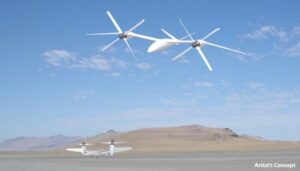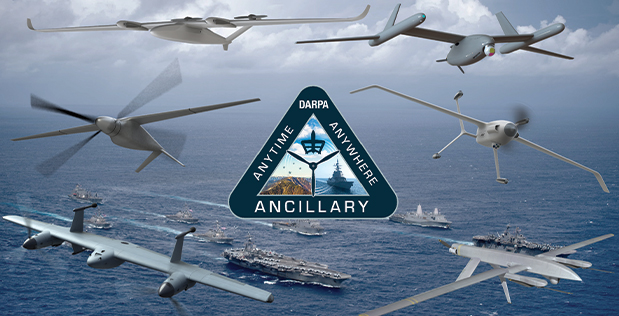DARPA (the Defense Advanced Research Projects Agency) has announced a competition for ANCILLARY (AdvaNced airCraft Infrastructure-Less Launch And RecoverY eVTOLs), or electric Vertical Take Off and Landing vehicles. (That’s about as tortured an acronym as we could cram into a lead paragraph.)
The goal, to develop a Class 3 unmanned VTOL aircraft capable of flying all-weather missions from ships or land, has been responded to by several industry leaders. These have been winnowed to six “finalists” who will craft demonstration models of their respective designs.
DARPA’s announcement includes the following: “The UAS would be able to launch and recover from ship flight decks and small austere land locations in adverse weather without additional infrastructure equipment, thus enabling expeditionary deployments. Unlike large VTOL systems, the small UAS size would allow many aircraft to be stored and operated from one ship creating a tactical beyond-line-of-site (BLOS) multi-intelligence sensor network capability.”
The Six Finalists
Phase Ia of the competition reduced the number of participants to six.
Phase Ib lists the six companies – AeroVironment, Griffon Aerospace, Karem Aircraft, Method Aeronautics, Northrop Grumman, and Sikorsky – who will submit “mature” X-plane designs. After detailed design and analysis companies will conduct component and configuration hover testing. Teams will concentrate on risk reduction before submitting competitive proposals for Phase II detailed design.
Steve Kominda, DARPA program manager for ANCILLARY, hopes for increased, “Uncrewed aerial system (UAS) capabilities by a factor of three over the current state-of-the-art flying today,.. Our performers are searching for innovative ways to increase payload weight and range/endurance of small, ship-launched UAS by means of novel configurations, propulsion, and controls while also removing the need for special infrastructure.” “
All six aircraft stem from experience with unpiloted systems and a high degree of autonomy.
Aerovironment Wildcat
Aerovironment’s Wildcat is a Group 3 vertical take-off and landing (VTOL) uncrewed aircraft system (UAS) developed specifically to execute ship-based operations in challenging maritime environments.
Chris Fisher, AV’s Vice President of MacCready Works, says, “We have prioritized controllability to ensure Wildcat meets the ‘anytime, anywhere’ goal of DARPA’s ANCILLARY program. Wildcat leans on autonomy to reduce operational burdens while enabling safe, infrastructure-less launch and recovery in challenging conditions from a range of Navy ships.” Disappointingly, the video below seems to be the only hint we get of what Wildcat will look like.
Wildcat deploys AV’s SPOTR-Edge machine learning-enabled computer vision “to enhance mission effectiveness.” Effectiveness comes from millions of operational flight hours on AV’s Raven®, Puma™ AE, and JUMP® 20 uncrewed systems.
Griffon Aerospace
Griffon’s Valiant will have four propellers driven by electric tilting motors powered by a yet undisclosed hybrid power source. The carbon-fiber structure will be carried aloft by “one long thin main wing and a V-tail. Landings can take place on the craft’s belly or on a landing frame.
As with all the other entrants, the Valiant will have distributed electric propulsion, swappable payloads that offer a full range of ISR (intelligence, surveillance, target acquisition, and reconnaissance) missions, and the ability to take off and land on ships’ decks or ground-based small, unimproved landing sites.
Karem Aviation
A likely entrant, Karem’s Bluebird is, “A contrarotating, coaxial Optimum Speed Tilt Rotor (OSTR) aircraft. With a high wing and inverted V-tail, the carbon composite airframe houses a 40 hp heavy-fuel propulsion system. Excellent maneuverability required for shipboard operation is achieved using the rigid rotors’ powerful control capacity.”
Bluebird will probably incorporate Near Earth Autonomy’s state-of-the-art autonomy system providing operator-free takeoff and landing from Naval shipping and austere sites.

Description suggests coaxial rotors, but illustration shows contra-rotating rotors. We’ll have to wait and see. Karem is allied with Boeing and Aurora Flight Sciences on this project
Bluebird is optimized for loiter endurance at extended ranges, with range and endurance necessary for successful missions.
According to Karem, “The variable rotor RPM OSTR provides unmatched rotorcraft efficiency and offers a step change in VTOL performance.”
Method Aeronautics
We’re not sure what Method Aeronautics has in store, but the firm designed, built and flew the Vanilla Aircraft VA001, a 36-foot wingspan, 600-pound, machine that set several endurance records in. Method’s entry will doubtless stress efficient aerodynamics.
Vanilla has set several records including an October 2, 2021 flight lasting eight days and 50 minutes. Flying from Edwards AFB in California and covering 10,600 nautical miles (19,600 kilometers) in circuits, this was an internal combustion engine-powered UAV record ratified by the FAI. Only the Rutan Voyager has flown longer unrefueled.
Northrop Grumman
The makers report, “Northrop Grumman’s ANCILLARY demonstrator will be capable of carrying a large 60-pound sensor payload with greater endurance of 20 hours’ time on station and mission radius range of 100 nautical miles,. The system will also have capability to land on a ship in adverse weather conditions.” They also claim the need for fewer supporting components than other, probably competing ANCILLARY designs.
The aircraft will be capable of performing intelligence, surveillance, reconnaissance and targeting missions, and supporting expeditionary missions for special operations forces and logistical missions with significant affordability impacts for ship-to-shore transition of parts and supplies.
Sikorsky
Sikorsky’s offering is, “A twin proprotor ‘rotor blown wing’ configuration that sits on its tail to take-off and land like a helicopter, and transitions easily to horizontal forward flight for long-endurance missions, such as intelligence, surveillance, reconnaissance and targeting.”
‘”Rotor blown wing” refers to the constant airflow from the proprotor wash across the wing. This provides efficiency during all flight phases.
Igor Cherepinsky, director of rapid prototyping group Sikorsky Innovations, explains. “Flight tests are underway to verify our tail-sitting rotor blown wing UAS can launch and land vertically with high stability, and cruise efficiently on wing, Key enablers to flight maneuverability, and future vehicle scalability, are our MATRIX autonomy flight control system, and an articulated rotor system similar to those in traditional helicopters.”
Using a battery-powered proof-of-concept prototype to confirm stability during vertical take-off and landing operations, and to test for efficient horizontal cruising, a future 300-pound hybrid prototype will include the 60-pound ISR payload common to all the ANCILLARY vehicles.
Non-Military Uses
One can see these autonomous vehicles being used in other, non-military pursuits. Search and rescue, for instance, or disaster assistance. One could see their application in tracking down escaped convicts, finding lost hikers, or detecting imminent fires through their sophisticated sensor systems. They could fly in supplies to workers in remote locations. One has the sense that these craft will find many uses in many missions.

